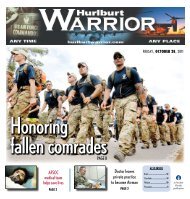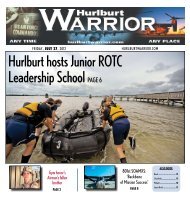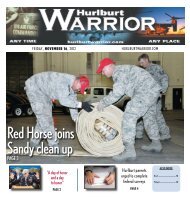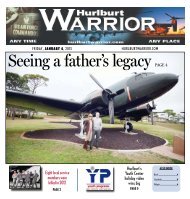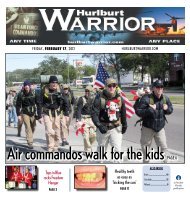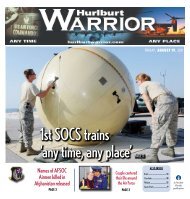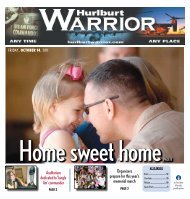1st SoFSS wins hennessy award - Hurlburt Warrior
1st SoFSS wins hennessy award - Hurlburt Warrior
1st SoFSS wins hennessy award - Hurlburt Warrior
Create successful ePaper yourself
Turn your PDF publications into a flip-book with our unique Google optimized e-Paper software.
Page | <strong>Hurlburt</strong> <strong>Warrior</strong> | Friday, April 13, 2012<br />
Children take aim at an invasive species<br />
By Senior Airman .<br />
Joe McFadden<br />
<strong>1st</strong> Special Operations Wing<br />
Public Affairs<br />
As protected and secure<br />
from external threats as a<br />
military installation can be,<br />
<strong>Hurlburt</strong> Field is still subject<br />
to a potential invasion.<br />
The invaders in question<br />
aren’t hostile terrorists, unwanted<br />
solicitors or even<br />
human, but Osteopilus septentrionalis,<br />
or the Cuban<br />
tree frog.<br />
These warty, white amphibians<br />
with their large toepads<br />
and “bug eyes” can<br />
wreak havoc on the local<br />
ecosystem and its inhabitants.<br />
But the base’s first<br />
line of defense against them<br />
will actually be in the hands<br />
of children.<br />
Nearly 30 elementary<br />
school-age children decorated<br />
and placed two frog<br />
houses on base April 6 to<br />
monitor the frogs’ progress<br />
into this part of Northwest<br />
Florida.<br />
The frog is native to<br />
islands like Cuba, the Bahamas<br />
and the Cayman Islands,<br />
however they have<br />
been introduced across<br />
Florida. The species prey<br />
upon other tree frogs which,<br />
if left unchecked, could<br />
lead to the native frogs’<br />
endangerment.<br />
The Cuban tree frog not<br />
only preys on other types of<br />
frogs but is drawn to electrical<br />
circuitry, which can<br />
lead to widespread power<br />
outages, said Kristal Walsh,<br />
natural/cultural resource<br />
manager of <strong>1st</strong> Special<br />
Operations Civil Engineer<br />
Squadron.<br />
“Most of the time here<br />
in Northwest Florida, we<br />
think of invasive species<br />
as plants but in fact, other<br />
types of animals, reptiles<br />
and amphibians are no<br />
longer exclusive to South<br />
Florida,” Walsh said. “It is<br />
important especially for<br />
children to understand not<br />
to release into the wild that<br />
pet snake or frog that they<br />
have grown tired of. That<br />
is just one of the ways invasive<br />
species are introduced<br />
into our ecosystems.”<br />
To check the frog’s population<br />
density on base, <strong>1st</strong><br />
SOCES personnel used<br />
segments of PVC pipe as<br />
houses. The children used<br />
markers to draw rainbows,<br />
frogs and their own names<br />
to add their own touch to<br />
the frog houses.<br />
VA DISABILITY CLAIM DENIED?<br />
Getting the runaround? Confused by the VA claims process?<br />
Don’t know what to do next? Let us handle your VA<br />
disability claim and deal with the VA so you don’t have to!<br />
Call William K. Thames at Lozier, Thames & Frazier for<br />
a free consultation. No fees or costs unless we recover VA<br />
benefits for you.<br />
24 West Chase Street, Pensacola, FL 32502<br />
Phone: 850/469-0202 Fax: 850/469-0006<br />
www.LTFLaw.com<br />
DISABILITY INJURY ESTATE PLANNING<br />
2078392<br />
Courtesy photo | USAF<br />
<strong>Hurlburt</strong> Field Youth Center children and staff pose with Kristal Walsh, natural/cultural<br />
resources manager of <strong>1st</strong> Special Operations Civil Engineer Squadron, center, after<br />
placing a PVC pipe frog house near a creek outside the base child development center<br />
at <strong>Hurlburt</strong> Field, April 6. The house will be used to monitor the population and movement<br />
of the Cuban tree frog, an invasive species.<br />
“The frogs like to sit inside<br />
the pipe where they<br />
2043218<br />
can wait for their next meal<br />
and where they are sheltered<br />
from the weather,”<br />
Walsh said. “These will be<br />
monitored both by the Natural<br />
Resources flight and<br />
by the children on a regular<br />
basis. If a Cuban Tree Frog<br />
is found, it will be removed<br />
and reported to the University<br />
of Florida and also other<br />
invasive species experts<br />
in the area.”<br />
While designing the<br />
houses, the children learned<br />
about the different types of<br />
frogs, including native and<br />
introduced species and<br />
their diets.<br />
“We learned that some<br />
frogs are bad and some are<br />
good,” said Jas Cathey, 7.<br />
“We also learned that some<br />
frogs have different dots<br />
so you can tell which is<br />
which.”<br />
Once completed, the<br />
children along with <strong>1st</strong> SO-<br />
CES personnel planted the<br />
houses near a newly-constructed<br />
stream outside the<br />
See children page 8



